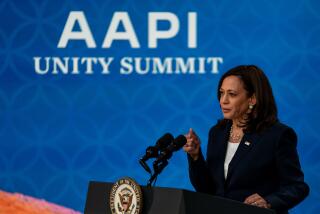Op-Ed: Why successful Asian Americans are penalized at the workplace

The onslaught of anti-Asian hate during the pandemic has caused Asian Americans to speak out against the vicious attacks and blatant racism. It has also forced people to confront less violent forms of discrimination, such as implicit bias and stereotypes that have long been used to hold Asian Americans back in the workplace.
Asian Americans have a strong presence in corporate America, but they are virtually absent in the executive suites. They represent 12% of the country’s professional workforce, yet less than 1% of S&P 500 CEOs were of East Asian descent. They are the least likely group to be promoted to management — less likely than any other racial group, including African Americans and Latinos.
Companies that aspire to diversify their leadership teams must increase transparency and build management programs to dismantle this corporate glass ceiling, which has barred Asian Americans from leadership ranks for decades.
This ceiling exists in education, legal, financial services and medical professions. Even in the technology sector, where Asian Americans have a big presence, the ceiling was consistently harder for Asian Americans to crack than for white employees at Google, Hewlett-Packard, Intel, LinkedIn and Yahoo, according to one study. Asians made up 27% of the professional workers at those five companies, but only 14% of executive positions; whites were 62% of the professionals, yet held 80% of the executive positions.
Asian Americans are often portrayed as a model minority — well educated, hard-working and successful. For this reason, they are regularly left out of discussions about discrimination in the workplace and overlooked for promotion. In fact, Asians are often excluded in diversity and inclusion plans entirely.
The model minority myth has even made Asian Americans invisible during the pandemic. They are rarely mentioned by the media in economic impact reports, even though they have faced the sharpest increase in long-term unemployment. This is not surprising, since there is little understanding that 12% of Asian Americans live in poverty and that there is a huge disparity of education and income levels among Asian Americans.
For Asian workers, the anti-Asian violence has triggered demands to address the employment bias that hinders their career growth. The stereotypes — lack of leadership qualities and assertiveness — are particularly used against women, who are seen as docile and unable to fit in with the corporate executive culture.
American corporations will have to root out this kind of racial bias if they want to develop leaders who reflect an increasingly diverse employee and customer base.
The workforce in the U.S. is changing, with Asian Americans the fastest-growing racial or ethnic group. Forward looking companies need to define the characteristics of a successful leader more broadly. Indeed, even in recruitment, members of Gen Z (people born after 1996) care passionately about diversity and inclusion in their workplaces. The issue for corporate America is how to develop leaders from all groups, including Asian Americans.
The first step is to collect and share information about career progression and promotion statistics of employees from entry level to executive level by different affinity groups such as age, race, ethnicity, gender and LGBTQ. Major firms such as Google, Ernst & Young and Deloitte are sharing their diversity and inclusion reports. These reports provide information about employee satisfaction and inclusive culture (sense of belonging, feeling free to be authentic at work, being respected at work) for different groups.
I am a surgeon in a privileged profession, but structural anti-Asian racism plagues medicine as it does other sectors of society.
This form of transparency can help in recruiting new talents. It can also help companies retain top talents if they use this information to gauge an employee’s sense of belonging and engage employees in constructive dialogues about career progression, pay gap and the work environment.
More importantly, this information can make the glass ceiling effect more visible. That visibility can stimulate a constructive dialogue between Asian American employees and senior management to discuss ways to reduce unconscious bias and to develop leadership programs.
The second step is to provide a fair opportunity for Asian American employees to take up skill-stretching assignments. Racial stereotypes pigeonhole them in positions that often require technical expertise. And because they are seen as deferential worker bees, Asian Americans are rarely given the opportunity to work on assignments that can develop their strategic and leadership skills. Lacking these opportunities, the glass ceiling becomes impossible to crack.
To break this vicious cycle, senior management could form a pool of eligible employees, provide strong training in management and communications, and establish rotation programs so that each employee has a chance to develop those skills.
As the U.S. workforce becomes more diverse, developing diverse leaders in the pipeline will be important for companies. Demolishing the glass ceiling for Asian Americans now is both an economic and moral obligation.
Christopher S. Tang is Distinguished Professor and the Edward W. Carter Chair in Business Administration at UCLA.
More to Read
A cure for the common opinion
Get thought-provoking perspectives with our weekly newsletter.
You may occasionally receive promotional content from the Los Angeles Times.











